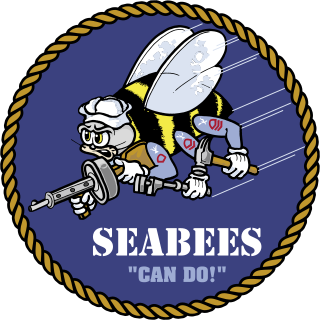
United States Naval Construction Battalions, better known as the Navy Seabees, form the U.S. Naval Construction Force (NCF). The Seabee nickname is a heterograph of the initial letters "CB" from the words "Construction Battalion". Depending upon context, "Seabee" can refer to all enlisted personnel in the USN's occupational field 7 (OF-7), all personnel in the Naval Construction Force (NCF), or Construction Battalion. Seabees serve both in and outside the NCF. During World War II they were plank-holders of both the Naval Combat Demolition Units and the Underwater Demolition Teams (UDTs). The men in the NCF considered these units to be "Seabee". In addition, Seabees served as elements of Cubs, Lions, Acorns and the United States Marine Corps. They also provided the manpower for the top secret CWS Flame Tank Group. Today the Seabees have many special task assignments starting with Camp David and the Naval Support Unit at the Department of State. Seabees serve under both Commanders of the Naval Surface Forces Atlantic/Pacific fleets as well as on many base Public Works and USN diving commands.

The Mariana and Palau Islands campaign, also known as Operation Forager, was an offensive launched by United States forces against Imperial Japanese forces in the Mariana Islands and Palau in the Pacific Ocean between June and November 1944 during the Pacific War. The United States offensive, under the overall command of Chester W. Nimitz, followed the Gilbert and Marshall Islands campaign and was intended to neutralize Japanese bases in the central Pacific, support the Allied drive to retake the Philippines, and provide bases for a strategic bombing campaign against Japan.

The Battle of Tinian was a battle of the Pacific campaign of World War II, fought on the island of Tinian in the Mariana Islands from 24 July until 1 August 1944. The 8,000-man Japanese garrison was eliminated, and the island joined Saipan and Guam as a base for the Twentieth Air Force.
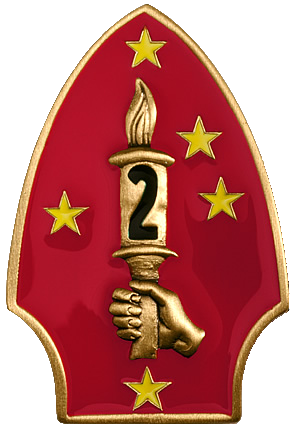
The 2nd Marine Division is a division of the United States Marine Corps, which forms the ground combat element of the II Marine Expeditionary Force. The division is based at Marine Corps Base Camp Lejeune, North Carolina and headquartered at Julian C. Smith Hall.

The 2nd Marine Regiment is an infantry regiment of the United States Marine Corps. They are based at Marine Corps Base Camp Lejeune, North Carolina and fall under the command of the 2nd Marine Division and the II Marine Expeditionary Force.

The 6th Marine Regiment is an infantry regiment of the United States Marine Corps based at Marine Corps Base Camp Lejeune, North Carolina. The regiment falls under the command of the 2nd Marine Division of the II Marine Expeditionary Force. Its combat history dates back to World War I when they were part of the American Expeditionary Force. They fought in the Pacific Theater in World War II, most notably at the battles of Guadalcanal, Tarawa, Saipan, Tinian and Okinawa. More recently, the regiment has seen combat during the Gulf War and in support of Operation Iraqi Freedom.

The 23rd Marine Regiment is a reserve infantry regiment of the United States Marine Corps. It is headquartered in San Bruno, California and falls under the command of the 4th Marine Division and the Marine Forces Reserve.

On 15 June 1944, United States Marine forces landed on the southwest coast of the island of Saipan in the central Marianas chain; these were followed a day later by US Army forces. This invasion was part of Operation Forager, an effort to recapture the entire Marianas chain from the Empire of Japan.

2nd Assault Amphibian Battalion is a mechanized battalion of the United States Marine Corps. Their primary weapon system is the Amphibious Assault Vehicle. The battalion is a separate battalion within the 2nd Marine Division and the II Marine Expeditionary Force. The unit is based out of the Camp Lejeune, North Carolina
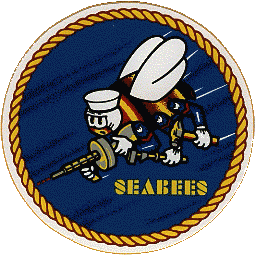
When World War II broke out the United States Naval Construction Battalions (Seabees) did not exist. The logistics of a two theater war were daunting to conceive. Rear Admiral Moreell completely understood the issues. What needed to be done was build staging bases to take the war to the enemy, across both oceans, and create the construction force to do the work. Naval Construction Battalions were first conceived at Bureau of Yards and Docks (BuDocks) in the 1930s. The onset of hostilities clarified to Radm. Moreell the need for developing advance bases to project American power. The solution: tap the vast pool of skilled labor in the U.S. Put it in uniform to build anything, anywhere under any conditions and get the Marine Corps to train it. The first volunteers came skilled. To obtain these tradesmen, military age was waived to age 50. It was later found that several past 60 had managed to get in. Men were given advanced rank/pay based upon experience making the Seabees the highest paid group in the U.S. military. The first 60 battalions had an average age of 37.
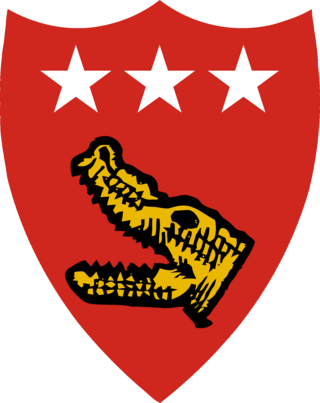
The V Amphibious Corps (VAC) was a formation of the United States Marine Corps which was composed of the 3rd, 4th and 5th Marine Divisions in World War II. The three divisions were the amphibious landing force for the United States Fifth Fleet with two goals, removal of Japanese forces from islands so U.S. Seabees could build advance bases to project US power. In doing this VAC was notably involved in the battles for Tarawa, Saipan, and Iwo Jima. V Amphibious Corps was commanded by General Holland 'Howlin Mad' Smith followed by General Harry Schmidt.

20th Marine Regiment was a Composite Engineer Regiment of the United States Marine Corps that fought during World War II.

The 19th Marine Regiment was a composite engineer regiment of the United States Marine Corps subordinate to the 3rd Marine Division. It existed from September 1942 until September 1944. In December 1943 there was a large change of command in the Regiment. Marine engineer regiments were eventually disbanded in favor of independent engineering battalions within the parent Marine divisions.

The 17th Marine Regiment was a composite engineer regiment of the United States Marine Corps subordinate to the 1st Marine Division. It was formed primarily from units of the Division, and was inactivated during war with the 1st and 2nd battalions remaining in the Division.

Naval Mobile Construction Battalion 133 is a United States Navy Construction Battalion, otherwise known as a Seabee Battalion, homeported at the Naval Construction Battalion Center. The unit was formed during WWII as the 133rd Naval Construction Battalion. It saw action and was decommissioned shortly after the war ended. The unit was reactivated as Mobile Construction Battalion 133 for the Vietnam War and remains an active unit today.

Naval Mobile Construction Battalion 25 or NMCB 25 is a Navy Reserve Seabee unit that is headquartered at Port Hueneme, CA. Its World War II predecessor was one of three CBs transferred to the Marine Corps in the late summer of 1942 as combat engineers. Those three battalions were attached to composite Marine Engineer Regiments as the third battalion of their respective regiment. All of them remained with the Marine Corps for the next two years before they were released and returned to the Navy. At the end of World War II the battalion was decommissioned. In 1961, it was recommissioned in the Naval Construction Force Reserve where it remains today.
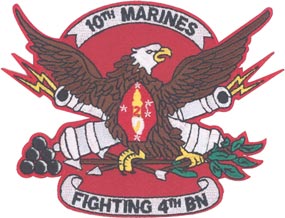
4th Battalion 10th Marines (4/10) was an artillery battalion in the United States Marine Corps that was formed on 11 April 1941 just prior to America's entrance into World War II and served until the end of the 1980s. It fought at the Battle of Tarawa and the Battle of Saipan during World War II and was sent to Cuba during the Cuban Missile Crisis in case hostilities broke out. The battalion was deactivated for the last time in 1989 and remains in an inactive status today.

Naval Construction Battalion 5 was commissioned on May 25, 1942 at Camp Allen Va. The battalion went to Port Hueneme and shipped out for the first of two deployments in the Pacific. When the war ended CB 5 was decommissioned in the Philippines. On July 10, 1951 the Battalion was re-commissioned as a MCB and remains an active unit today.

John Houghton Griebel was a decorated officer in the United States Marine Corps with the rank of Brigadier general. A veteran of Nicaraguan Campaign and Yangtze Patrol, he later distinguished himself as commanding officer, 5th Marine Regiment during the Battle of Okinawa.

On 15 September 1944, United States Marine Corps forces landed on the southwestern shore of the island of Peleliu in the Palau island chain, 470 nautical miles due east of the Philippine island of Mindanao. This action, called Operation Stalemate II by American planners, was a phase in the Pacific Theatre of World War II. Whether possession of the island was necessary for the Allied cause has been the source of much controversy.























